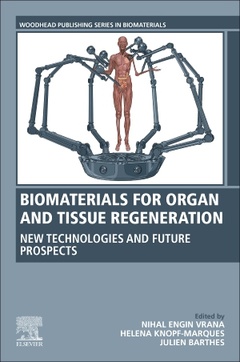Biomaterials for Organ and Tissue Regeneration New Technologies and Future Prospects Woodhead Publishing Series in Biomaterials Series
Coordonnateurs : Vrana Nihal, Knopf-Marques Helena, Barthes Julien

Biomaterials for Organ and Tissue Regeneration: New Technologies and Future Prospects examines the use of biomaterials in applications related to artificial tissues and organs. With a strong focus on fundamental and traditional tissue engineering strategies, the book also examines how emerging and enabling technologies are being developed and applied. Sections provide essential information on biomaterial, cell properties and cell types used in organ generation. A section on state-of-the-art in organ regeneration for clinical purposes is followed by a discussion on enabling technologies, such as bioprinting, on chip organ systems and in silico simulations.
Section 1: Biomaterials
2. Classes of Biomaterials used in Tissue/Organ Regeneration
3. Physicochemical Properties of Biomaterials
4. Synthesis or Modification of Biomaterials for Regenerative Medicine Applications
5. Surface Modifications of Biomaterials for Tissue Engineering
Section 2: Cell microenvironment and signalling
6. Cell microenvironment and ECM
7. Cell signalling and strategies to modulate cell behaviour
Section 3: Cells
8. Stem cells: sources, properties and cell types
9. Tissue specific cells: sources, properties and cell types
10. Cell differentiation: sources, properties and cell types
11. Immune cells: sources, properties and cell types
12. Angiogenesis/vascular cells: sources, properties and cell types
Section 4: Organ specific Artificial tissues/Organs
13. Heart/Cardiovascular tissues
14. Respiratory system tissues
15. Digestive system tissues
16. Kidney Tissue Engineering
17. Liver Tissue Engineering
18. Pancreas Tissue Engineering
19. Neural Tissue Engineering
20. Musculoskeletal Tissue engineering
Section 5: Biotechnological approaches and Enabling technologies related to organ regeneration
21. Emerging biotechnological approaches with respect to organ regeneration: SiRNA, miRNA, CRISPR, CAR-T therapy, -omics approaches etc.
22. Bioreactors
23. On-chip organ systems
24. In vitro disease and organ models
25. Bioprinting
26. Biorobotics
27. Imaging techniques for biomaterials, stem cells and engineered tissues/organs
28. Future perspectives/Industrialisation and Up-scaling of organ regeneration technologies
Helena Knopf-Marques is a Senior Researcher at PROTiP Medical. She has also been associate professor at Strasbourg University. She has been working with the development of new biomaterials since her graduation. She is a Chemical Engineer with a masters in Mechanical Engineering. She received her PhD from the Program in Metallurgical and Materials Engineering at Federal University of Rio de Janeiro. Her main research interests are tissue engineering, multifunctional coatings, immunomodulation of biomaterial surfaces, 3D printing and cell biomaterial interactions. She is presently working on the EU Horizon 2020 project PANBioRA that aims to develop new instruments for biomaterials characterization and risk assessment.
Dr. Julien Barthes is collaborative Project Manager at PROTiP MEDICAL. He holds two master’s degrees in physical/chemical properties of polymers and in polymer science (ECPM, Strasbourg). He obtained in PhD in 2014 at Strasbourg in Inserm (French National Institute of Health and Medical Research) in “Biomaterials and Bioengineering department His main research areas are hydrogel development, titanium implants, tissue engineering, cell biomaterials interactions, release of bioactive molecules in cell microenvironment and 3D printing. He is a scientific contributor in Horizon 2020European Proje
- Provides a systematic overview of the field, from fundamentals, to current challenges and opportunities
- Encompasses the classic paradigm of tissue engineering for creation of new functional tissue
- Discusses enabling technologies such as bioprinting, organ-on-chip systems and in silico simulations
Date de parution : 03-2020
Ouvrage de 846 p.
15x22.8 cm
Thèmes de Biomaterials for Organ and Tissue Regeneration :
Mots-clés :
?3D culture; Adipocytes; Adipose stem cells; Adipose tissue reconstruction; Advanced biosystems; Angiogenesis; Aortic allograft; Arterial; Artificial larynx; Astrocytes; Bioactive dressing; Bioartificial pancreas; Biofabrication; Biomaterial risk assessment; Biomaterials; Biomechanics; Biomimetic approaches; Bioreactors; Bladder; Blood–brain barrier; Bone; Bone morphogenetic protein; Bone tissue engineering; Brain microvascular endothelial cells; Brain vascularization; Bulk properties; Capillary-like structures; Carbon nanotubes; Cardiac; Cartilage; Cell adhesion; Cell isolation; Cell line; Cell migration; Cell signaling; Cell therapy; Cell-sheet technology; Cell-therapy; Compliance; Controlled degradation; Coronary artery bypass graft; Cross; Diabetes; Diabetic foot ulcer (DFU); Diabetic wound healing; Electrospinning; Engineered biomaterials; Enthesis; Extracellular matrix; Fat graft vascularization; Foreign body reaction; Functionalization; Graphene; Growth factor therapy; Growth factors; HA derivatives; Hyaluronic acid; Hydrogels; IPSC; Immunology; Implants; Insulin; Integrins; Interfaces; Intestinal regeneration; Intestinal stem cells; Islet transplantation; Kidney; Laryngeal transplantation; Laryngotracheal reconstructive surgical procedures; Linking method; Lung and liver cell line models; Material discovery; Mathematical model of liver cell aggregation; Mechanical properties; Mechanobiology; Mechanotransduction; Microfluidics; Micropatterning; Microphysiological systems; Model of bioreactor for lung cells; Nanocages; Nanocomposite hydrogel systems; Nanomaterials; Nanoparticles; Nanopatterning; Nanorods; Nanoscale-delivery systems; Nanotubes; Natural scaffolds; Nerve; Neurogenesis; Nuclear response; On-chip models; Organ-on-a-chip; Organoid culture; Organoids; Perfusion; Pericytes; Phenotype



